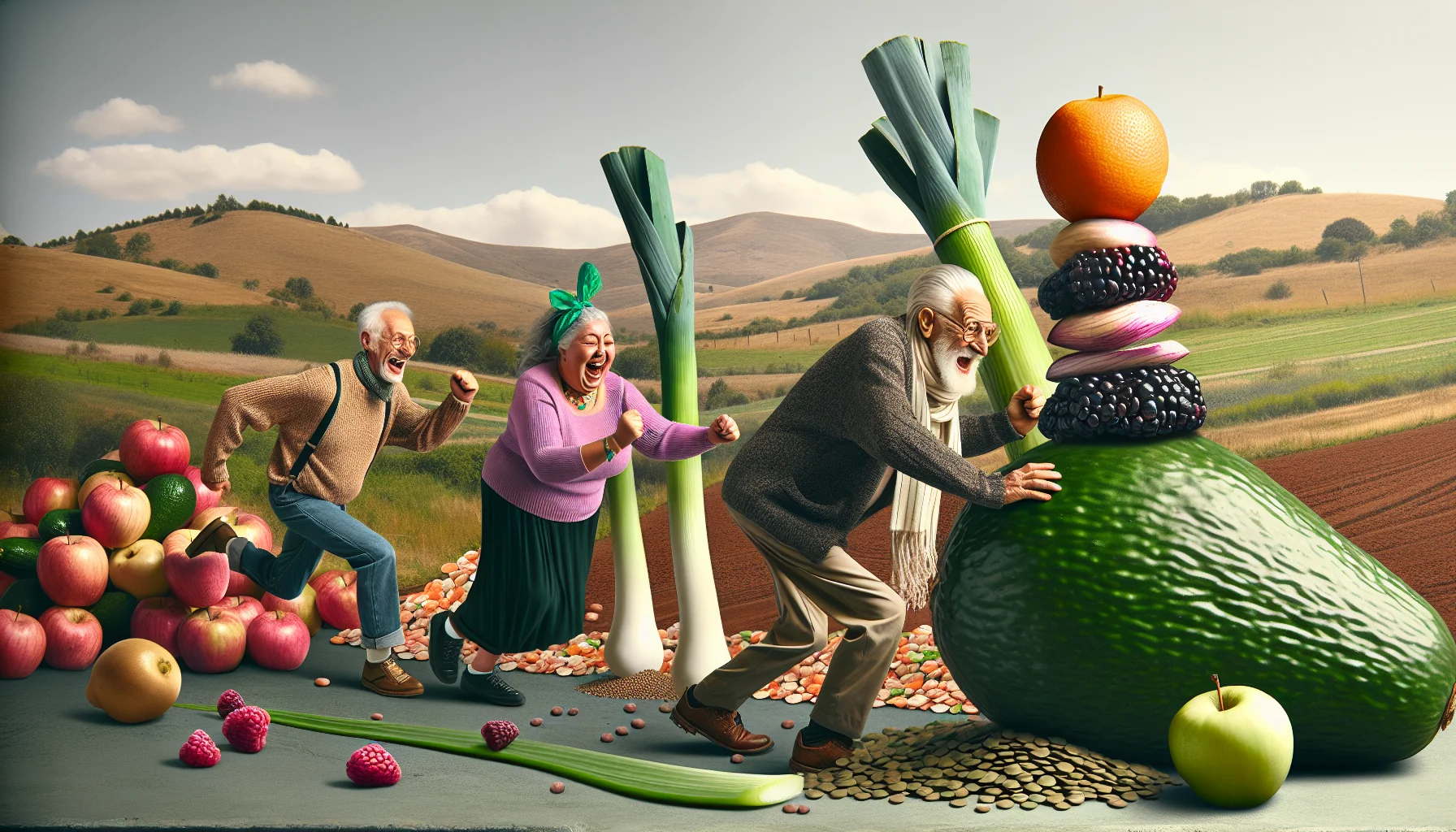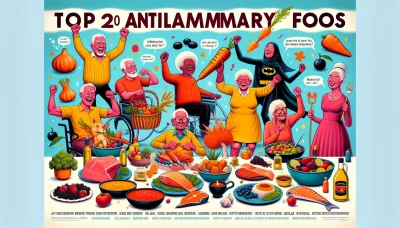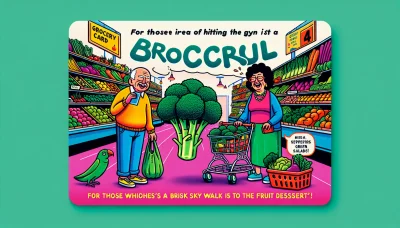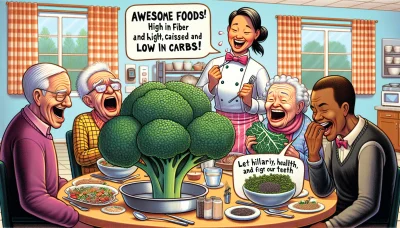High fiber foods for weight loss Quiz
Test Your Knowledge
Question of
Understanding High Fiber Foods
The Role of Fiber in Weight Management
Fiber is a powerhouse when it comes to weight management! It's not digested by your body, so it helps you feel full without adding extra calories. Imagine eating less but feeling satisfied that's the magic of fiber!
High fiber foods are like nature's appetite suppressants. They expand in your stomach and slow down digestion, which means you're likely to say "no thanks" to seconds. This can lead to eating fewer calories throughout the day, nudging that scale in the right direction.
How Fiber Aids in Satiety
Chew on this foods rich in fiber take longer to eat and digest, making you feel full sooner and for a longer period! It's like having a natural portion control assistant with every meal.
Fiber has an uncanny ability to absorb water, turning into a gel-like substance in your gut. This slows down the emptying of your stomach, meaning those hunger pangs won't come knocking as soon. You'll be powering through your day without constant snack breaks!
Fiber's Impact on Metabolism
Digging into high fiber foods can actually rev up your metabolism! Since your body works harder to break down fiber-rich foods, you burn more calories just by eating them. Its like getting a workout at the dinner table.
Moreover, by regulating blood sugar levels, fiber helps prevent insulin spikes that can lead to weight gain. Its like having an internal weight management coach keeping things balanced!
Types of Dietary Fiber
Not all fibers are created equal! There are two main types: soluble and insoluble. Each plays a unique role in our health, and both are crucial for a well-rounded diet.
Soluble vs. Insoluble Fiber
Soluble fiber dissolves in water and turns into a gel during digestion, helping to lower glucose and cholesterol levels. Oats and beans are champions of soluble fiber!
Insoluble fiber, on the other hand, doesn't dissolve. It acts like a broom for your digestive system, keeping things moving smoothly along. Whole grains and many vegetables are packed with this type of fiber.
Prebiotic Fiber and Gut Health
Here's something cool certain high-fiber foods act as prebiotics, feeding the good bacteria in your gut! This can lead to improved digestion, stronger immunity, and even better mental health.
Prebiotic fibers found in foods like garlic, onions, and bananas not only promote gut health but also enhance calcium absorption. Its like giving a gift to your gut every time you eat them!
Recommended Daily Fiber Intake
- *Priority Lists: Organize your daily fiber sources based on their importance or density. *Checklists: Keep track of how much fiber you've consumed throughout the day. *Descriptive Lists: Note each food item along with its corresponding fiber content. *Comparative Lists: Compare different food items to make smarter choices based on their fiber content. *Enumerative Lists: -Ordered Lists: Prioritize high-fiber meals throughout your day. -Unordered Lists: Compile a list of go-to high-fiber snacks regardless of order. *Multilevel Lists: Break down each meal into primary ingredients and their respective fiber contribution. *Matrix Lists: Create a weekly meal plan grid highlighting fiber-rich foods for each day.
Fiber Guidelines for Different Age Groups
Different stages of life require different amounts of fiber. Kids need less than adults; men typically need more than women. Tailoring your intake based on age ensures optimal health benefits.
The general guideline suggests women should aim for 25 grams per day while men should target 38 grams. After age 50, these numbers drop slightly due to changes in digestion and metabolism.
Adjusting Fiber Intake for Weight Loss Goals
If shedding pounds is your mission, boosting your daily fiber intake might be your secret weapon! Start by adding just a few grams at a time too much too fast can be counterproductive.
Increase water intake as you up the fiber it's essential for helping that dietary fiber work its wonders without discomfort. Gradually increasing both will have you feeling fabulous and fit!
Top High Fiber Foods to Include in Your Diet
Fruits Rich in Fiber
Integrating high-fiber fruits into your diet can work wonders for your health. Fruits like pears, bananas, and oranges are not only delicious but also packed with essential nutrients and dietary fiber. They aid in digestion and can help regulate blood sugar levels.
Berries are a powerhouse of taste and fiber. A cup of raspberries contains an impressive 8 grams of fiber. Not only do they make a delightful addition to any meal or snack, but their high fiber content also contributes significantly to weight loss efforts by promoting satiety.
Berries and Weight Loss
When it comes to shedding pounds, berries are your best friend. They're low in calories yet high in fiber, making them the perfect snack to keep you full without overindulging. The natural sweetness satisfies sugar cravings, helping you stay on track with your weight loss goals.
Apples as a Satiating Snack
An apple a day not only keeps the doctor away but also keeps hunger at bay! Apples boast about 4 grams of fiber per fruit, contributing to feelings of fullness. They're convenient to carry around and make for an easy, healthy snack between meals.
Vegetables That Boost Fiber Intake
Veggies are vital for a fiber-rich diet. From artichokes to sweet potatoes, the variety available means you'll never get bored. Including these in your meals increases nutrient intake while helping maintain a healthy digestive system.
Leafy Greens and Fullness
Leafy greens like spinach and kale are low in calories but high in fiber, making them ideal for maintaining a feeling of fullness. Integrating them into your diet can be as simple as adding them to smoothies or salads for a nutritious boost.
Cruciferous Vegetables for Caloric Control
Cruciferous vegetables such as broccoli and Brussels sprouts are champions of both fiber and nutrients. Their dense composition helps control calorie intake while providing substantial volumes that contribute to a feeling of satiety after meals.
Whole Grains for Sustained Energy
Ditching refined grains in favor of whole grains can lead to significant health benefits. Foods like brown rice, barley, and whole wheat contain more fiber than their processed counterparts, promoting better digestion and longer-lasting energy levels throughout the day.
- *Enumerative Lists: Used for itemizing elements, events, or tasks, often in a specific order. They can be further divided into: Ordered Lists: Sequence matters (e.g., procedural steps, rankings). Unordered Lists: Sequence does not matter (e.g., grocery lists, to-do lists). *Descriptive Lists: Each item is accompanied by additional details or a description. Useful for catalogs, menus, or directories. *Checklists: Designed for tracking completion or presence of items or tasks. Common in project management, inspections, and daily routines. *Multilevel Lists: Nested lists with items having sub-items. Useful for outlining complex information, hierarchical data, or detailed plans. *Matrix Lists: Information presented in a two-dimensional grid or table format, where lists are organized both vertically and horizontally. *Priority Lists: Items are organized based on their importance or urgency. Common in project management and personal productivity systems. *Comparative Lists: Used for juxtaposing two or more items, options, or ideas, often to highlight differences or similarities.
Oats and Their Role in Cholesterol Management
Oats are not just for breakfast; they're a versatile grain that can be enjoyed at any mealtime. Rich in beta-glucan fiber, oats have been shown to effectively lower bad LDL cholesterol levels when consumed regularly as part of a balanced diet.
Quinoa as a Protein and Fiber Source
Quinoa is a unique whole grain because it's also a complete protein source - meaning it contains all nine essential amino acids. With its high fiber content combined with protein, quinoa keeps you full longer and stabilizes blood sugar levels.
Incorporating High Fiber Foods into Meals
Breakfast Ideas to Kickstart Your Day
Starting your day with a high fiber meal can boost digestion and keep you feeling full longer. A breakfast brimming with fiber sets the tone for a day of healthy eating. It's not just about the quantity, but also the quality of fiber that counts!
High Fiber Smoothies: Blend leafy greens like spinach or kale with berries, chia seeds, and a banana for a powerhouse morning smoothie. This delicious concoction is not only refreshing but packs a serious fiber punch that will rev up your digestive system!
Fiber-Packed Oatmeal Recipes: Oatmeal isn't just warm and comforting; it's a fantastic canvas for high-fiber mix-ins. Top your bowl with nuts, seeds, and fresh fruit to transform this classic breakfast into a fiber feast that'll keep you energized all morning.
Lunch Options for Sustained Fullness
Lunch is the perfect time to incorporate high-fiber foods that'll prevent mid-afternoon slumps. A well-balanced meal rich in fiber can help maintain blood sugar levels, keeping you productive throughout the day.
Salads with High Fiber Toppings: Elevate your salads by sprinkling on nuts, seeds, and legumes. These toppings don't just add texture and flavor; they increase your fiber intake significantly, aiding in satiety and digestion.
Whole Grain Wraps and Sandwiches: Swap out white bread for whole grain options like rye or spelt. Add in plenty of vegetables and a bean spread for an extra fiber boost that will sustain you till dinner time.
Dinner Dishes for Weight Loss
Dinner can be a delightful way to wind down the day while still focusing on your health goals. Opting for dishes high in fiber can contribute to weight loss by making you feel full on fewer calories.
Stir-Fries with Fiber-Rich Veggies: Toss together broccoli, bell peppers, and snap peas with whole grain noodles or brown rice. This hearty stir-fry will satisfy your hunger while helping you stay on track with your weight loss journey.
Legume-Based Meals: Legumes are not only hearty and satisfying but are also packed with fiber. Consider a chickpea curry or black bean chili as a centerpiece of your dinner for an enjoyable meal that supports weight management.
- Mix it Up: Don't stick to just one type of high-fiber food; diversity is key to getting all types of fibers and nutrients.
- Stay Hydrated: As you increase your fiber intake, remember to drink plenty of water throughout the day to aid in digestion.
- Sneak Fiber In: Find creative ways to add more fiber-rich foods into dishes you already lovelike adding lentils to pasta sauce or veggies to casseroles.
Snacks and Desserts with High Fiber Content
Healthy Snacking for Weight Control
Healthy snacking is paramount in maintaining a balanced diet and managing weight. High-fiber snacks are not only filling but also provide sustained energy. They help reduce the urge to indulge in less healthy options that may lead to weight gain.
Choosing snacks rich in fiber aids digestion and can lower cholesterol levels. It's essential to integrate these into your daily routine for overall health benefits, including weight control. Remember, moderation is key even with healthy snacks!
Nuts and Seeds as Fiber Boosters
Nuts and seeds are powerhouses of nutrition, packed with fiber that keeps you full longer. Almonds, chia seeds, and flaxseeds, for example, offer a significant amount of fiber per serving. They're easy to incorporate into your diet sprinkle them on salads or yogurt.
Their versatility makes nuts and seeds an excellent snack option on the go. Just be mindful of portion sizes as they are also high in calories due to their fat content but it's the good kind of fat!
Popcorn as a Low-Calorie Fiber Source
Air-popped popcorn is a fantastic snack for those looking for a low-calorie, high-fiber option. Its whole grain, which means it retains all its fibrous goodness. When prepared without excessive butter or salt, its an incredibly healthy snack choice.
With its high volume, popcorn can help satisfy hunger with fewer calories while providing the fiber your body needs. Its a perfect guilt-free snack for movie nights or when you need something to munch on.
Desserts That Satisfy Sweet Tooth and Fiber Needs
Finding desserts that are both delicious and high in fiber doesnt have to be a challenge. There are numerous tasty options that fulfill your sweet cravings while contributing to your daily fiber intake.
Sweets don't always have to be seen as guilty pleasures; instead, they can be part of a balanced diet when chosen wisely and consumed in moderation.
Fruit-Based Desserts
- *Enumerative Lists: Used for itemizing elements, events, or tasks, often in a specific order. Ordered Lists: Sequence matters (e.g., procedural steps, rankings). Unordered Lists: Sequence does not matter (e.g., grocery lists, to-do lists). Descriptive Lists: Each item is accompanied by additional details or a description. Checklists: Designed for tracking completion or presence of items or tasks. Multilevel Lists: Nested lists with items having sub-items. Matrix Lists: Information presented in a two-dimensional grid or table format. Priority Lists: Items are organized based on their importance or urgency. Comparative Lists: Used for juxtaposing two or more items, options, or ideas.
Dark Chocolate and Its Fiber Content
Dark chocolate is not just a treat; its also loaded with fiber! Opting for chocolate with a high percentage of cocoa ensures less sugar and more fiber per bite. This makes dark chocolate an indulgent yet smart dessert choice.
A small square of dark chocolate can be both satisfying and beneficial. Besides fiber, it also contains antioxidants that contribute positively to heart health. Enjoy it alone or pair it with fruits like berries for an extra fiber boost.
Understanding the Glycemic Index in High Fiber Diets
Low Glycemic Foods for Weight Loss
Focusing on low glycemic foods is a game-changer for weight loss. These foods help maintain energy levels and reduce hunger pangs. By choosing low glycemic options, you're setting up a sustainable path towards shedding pounds.
Low glycemic foods are not just beneficial for weight management; they also support overall health. Incorporating these into your diet can lead to improved cholesterol levels and reduced risk of developing type 2 diabetes.
The Importance of Glycemic Control
Glycemic control is pivotal in managing weight and preventing chronic diseases. It involves regulating blood sugar levels to minimize spikes after meals. Mastering this can lead to a more balanced and healthful lifestyle.
Maintaining steady blood sugar levels is essential. It aids in reducing cravings and supports metabolic health. Opting for foods with a lower glycemic index can help achieve this balance.
Examples of Low Glycemic High Fiber Foods
- Legumes like lentils and chickpeas are packed with fiber and have a low glycemic index.
- Whole grains such as quinoa and barley offer sustained energy without spiking blood sugar.
- Non-starchy vegetables like kale and broccoli are nutrient-dense, high in fiber, and have minimal impact on glucose levels.
- Fruits such as berries and apples come with natural sugars but their high fiber content helps regulate absorption.
Balancing Carbohydrates and Fiber Intake
Balancing carbohydrates with fiber intake is crucial for maintaining optimal health. High-fiber carbs are digested slower, preventing rapid increases in blood sugar. This balance is key to a nutritious diet.
Understanding the composition of foods is vital for managing carbohydrate intake. Opting for whole, unprocessed foods rich in fiber can contribute to better blood sugar control and overall well-being.
Identifying High Carb Foods with High Fiber
Identifying high carb foods that are also high in fiber is essential for dietary balance. These foods provide satiety, reduce overeating, and support digestive health while supplying the body's energy needs.
Educating oneself about food choices makes a significant difference. Choosing complex carbs like whole grains over simple sugars ensures a higher fiber intake, which is beneficial for prolonged energy release.
Managing Portions and Blood Sugar Levels
Managing portions goes hand-in-hand with controlling blood sugar levels. Eating moderate amounts of high-fiber carbohydrates prevents overwhelming the body's insulin response.
Awareness of portion sizes can transform your health status. It empowers you to enjoy a variety of foods while keeping your blood sugar levels stable throughout the day.
The Synergy Between Fiber and Blood Sugar Stability
The synergy between dietary fiber and blood sugar stability cannot be overstated. Fiber plays a critical role in modulating the body's absorption of glucose, leading to more consistent energy levels throughout the day.
How Fiber Slows Glucose Absorption
Fiber slows down the absorption of glucose into the bloodstream, providing a steadying effect on blood sugar levels. This slow release mechanism ensures there are no sudden spikes or drops that could affect your health or mood.
The Benefits of Stable Blood Sugar for Weight Loss
Stable blood sugar levels contribute significantly to weight loss efforts by reducing unnecessary snacking and binge eating. When your energy levels are consistent, there's less temptation to reach for quick fixes like sugary snacks.
Maintaining stable blood sugar through a high-fiber diet also supports long-term health outcomes beyond weight loss. It's associated with lowered risk factors for several lifestyle-related conditions such as cardiovascular disease and diabetes.
Meal Planning and Preparation for a High Fiber Diet
Creating a Balanced High Fiber Meal Plan
A balanced high fiber meal plan is your ticket to a healthier lifestyle! It's about mixing various fiber-rich foods to meet your daily requirements. Think whole grains, legumes, fruits, and veggies. Incorporating these into each meal ensures you're on the right track. Remember, balance is key too much of one type isn't the way to go!
Don't forget variety! Rotate your greens, switch up your beans, and experiment with different whole grains. This not only keeps your taste buds excited but also ensures a broad range of nutrients. Plus, adding nuts and seeds gives that satisfying crunch and extra fiber boost!
Weekly Meal Planning Strategies
Dive into weekly meal planning by charting out your meals for the week ahead. This organized approach means less stress and more time to enjoy your delicious creations. Start with familiar recipes, then gradually introduce new fiber-packed dishes to spice things up!
When mapping out your week, consider color-coding meals based on their primary fiber source. This visual aid helps ensure diversity in your diet. And don't be afraid to prep in bulk cooking larger portions can save you time and keep your high-fiber goals on track.
Shopping Lists for High Fiber Foods
Create a master shopping list of high-fiber staples to streamline your grocery runs. Having this list on hand helps resist the temptation of less healthy options. Prioritize fresh produce, whole grains, and legumes they're the cornerstones of a fiber-rich diet.
- Fruits & Vegetables: Berries, pears, apples, leafy greens, and carrots.
- Whole Grains: Quinoa, brown rice, oats, and barley.
- Legumes: Lentils, black beans, chickpeas, and edamame.
- Nuts & Seeds: Almonds, chia seeds, flaxseeds, and pumpkin seeds.
- Bread & Pasta: Look for whole grain or 100% whole wheat options.
Cooking Techniques to Preserve Fiber Content
Steaming vs. Boiling Vegetables
To maximize the fiber content in vegetables, steaming is the champion! Unlike boiling which can leach nutrients into water, steaming preserves more of that precious fiber content. Plus it keeps veggies closer to their natural state crispier texture and vibrant colors!
The beauty of steaming is its simplicity; all you need is water and heat! No oils or fats required here just pure veggie goodness in its most fibrous form. So next time you're about to boil those broccoli florets or green beans consider steaming them instead for a nutrient-rich side dish.
Baking with Whole Grain Flours
Baking with whole grain flours doesn't just add complexity to flavors; it's also a genius move for boosting fiber intake! Swap out refined flours for their whole grain counterparts in breads, muffins, pancakes - the sky's the limit. Get ready for heartier textures and an extra dose of health benefits!
Keep an eye out for whole wheat flour but don't stop there! Explore other flour varieties like oat flour or spelt flour - each bringing unique qualities to your baked goods while ramping up that fiber content. And hey - why not add some oat bran or wheat germ for an even bigger fiber kick?
Storing High Fiber Foods Correctly
Keeping Fruits and Vegetables Fresh
Your high-fiber heroes fruits and veggies deserve VIP treatment when it comes to storage! Keep them fresh by understanding their individual needs; some crave cool fridge air while others prefer room temperature surroundings.
Fridge dwellers like leafy greens need moisture control bags that prevent wilting without suffocating them. And those countertop loungers? They need space to breathe so they can ripen just right. Think bananas hanging out away from the crowd they'll stay spot-on perfect longer!
Best Practices for Whole Grain Storage
To keep those high-fiber whole grains fresh as day one think cool, dark places away from moisture's reach. Airtight containers are their best friends; they keep bugs out and freshness in. Whether it's brown rice or quinoa - proper storage means longer shelf life!
If you've gone bulk-buying crazy with those grains no worries! Your freezer has got you covered. Freezing extends shelf life big time while keeping nutrient levels steady as a rock. Just make sure they're well-sealed before tucking them away in their chilly new home.
Overcoming Challenges with High Fiber Diets
Managing Digestive Issues When Increasing Fiber Intake
Fiber is a superstar in the world of nutrition, but cranking up your fiber intake too quickly can lead to some uncomfortable digestive party crashers like bloating and gas. The key is to give your gut time to adapt. Start with small increments in your fiber intake to let your body get used to the change. Your digestive system will thank you for not turning it into a gas factory overnight!
Water and fiber go together like peanut butter and jelly! They're a dynamic duo that helps keep things moving smoothly in your gut highway. When you increase your fiber intake, make sure you also up your H2O consumption. Think of it as lubrication for all that roughage without enough water, you might end up with traffic jams like constipation.
Dealing with Limited Food Choices
Eating out doesn't have to mean ditching your high-fiber diet at the door. Many restaurants are savvy about catering to health-conscious diners these days. Look for menu items laden with vegetables, whole grains, and legumes. You might be surprised at how easy it is to find a high-fiber feast even when you're not behind the stove!
Traditional recipes aren't set in stone they're more like guidelines, really! Get creative and swap out low-fiber ingredients with their high-fiber counterparts. Use whole grain flour instead of white, toss some beans into that beef stew, or sprinkle nuts over your salad. These simple tweaks can skyrocket the fiber content of your meals without sacrificing flavor.
- Read Menus Carefully: Look for keywords like "whole grain," "bran," or "fiber-rich."
- Ask Questions: Don't hesitate to ask the staff about the fiber content of dishes.
- Plan Ahead: Check out restaurant menus online before you go to strategize your meal choices.
- Customize Your Order: Request whole grain bread for sandwiches or brown rice instead of white.
- Cook at Home More: Home cooking gives you full control over ingredients and their fiber content.
Staying Motivated and Tracking Progress
Losing weight is a marathon, not a sprint setting realistic goals can prevent that feeling of discouragement when you don't become a supermodel overnight. Aim for attainable milestones that celebrate every bit of progress. A little self-kindness can go a long way toward keeping you on track without getting demotivated.
A food diary isn't just a place to confess your love affair with chocolate; it's an accountability buddy! Logging what you eat helps you stay conscious of your dietary choices and fiber intake. Plus, looking back at your food diary can be incredibly satisfying it's proof of how far you've come on your high-fiber journey!
The Future of Diets: Integrating High Fiber Foods for Long-Term Health
Research on High Fiber Diets and Disease Prevention
Groundbreaking research has unveiled the power of high fiber diets in warding off diseases. Experts are excitedly reporting that individuals who load up on fiber-rich foods are less likely to encounter heart disease, diabetes, and certain types of cancer. The mechanism? Fiber's role in regulating blood sugar and cholesterol, as well as its ability to promote a healthy gut microbiome.
The link between dietary fiber and reduced disease risk is becoming clearer by the day. A high intake of fiber has been associated with lower body weight and improved digestion, both key factors in maintaining overall health. This isn't just a fleeting trend; it's a robust finding supported by numerous studies.
The Link Between Fiber and Reduced Disease Risk
It's electrifying to see the connection between fiber intake and a decrease in disease risk. Fiber plays a crucial role in maintaining bowel health, which can significantly reduce the chances of developing colorectal cancer. Its ability to bind with toxins and waste also aids in protecting the body from harmful substances.
Moreover, high fiber foods are typically rich in essential nutrients that further bolster our defenses against illness. By embracing a diet abundant in fruits, vegetables, whole grains, and legumes, we're not just filling our plates with fiber; we're fueling our bodies with vitamins, minerals, and antioxidants.
Longitudinal Studies on Fiber Intake and Health Outcomes
Long-term studies have given us an exhilarating glimpse into the potential longevity benefits of high fiber diets. These longitudinal studies track participants over years, even decades, revealing that those with higher fiber consumption tend to live healthier lives with fewer medical issues.
The evidence is compelling: embracing a diet rich in high fiber foods can lead to significant health benefits over time. Its an investment in your future self that pays off with interest!
Sustainability of High Fiber Diets
Environmental Benefits of Plant-Based High Fiber Foods
The environmental perks of plant-based diets are causing quite the buzz! High fiber foods like legumes, nuts, seeds, fruits, and vegetables often require less water and land to produce than animal-based products. This shift towards plant-based eating is not just good for usit's essential for our planet's health!
By choosing high fiber options, we're reducing our carbon footprint dramatically. It's an incredible win-win situation where personal health goals align beautifully with environmental sustainability.
Economic Advantages of a High Fiber Diet
Let's talk numbershigh fiber diets can be incredibly cost-effective! Many high-fiber foods are not only nutritious but also affordable staples that can reduce your grocery bill. Think beans, oats, and brown riceall wallet-friendly options that pack a nutritional punch.
- *Enumerative Lists: Used for itemizing elements, events or tasks often in specific order *Descriptive Lists: Each item is accompanied by additional details or description *Checklists: Designed for tracking completion or presence of items or tasks *Multilevel Lists: Nested lists with items having sub-items *Matrix Lists: Information presented in a two-dimensional grid or table format *Priority Lists: Items are organized based on their importance or urgency *Comparative Lists: Used for juxtaposing two or more items,options or ideas
Personalizing Your High Fiber Diet
Tailoring Fiber Intake to Individual Needs
Personalizing your diet is criticalno one size fits all! Depending on age, gender, activity level, and health goals, fiber needs may vary greatly from person to person.
Incorporating Cultural Preferences into a High Fiber Diet
Its thrilling how easily high-fiber diets can dance across different cuisines! Embracing cultural diversity in your diet enriches your palate while still reaping all fibrous benefits.












